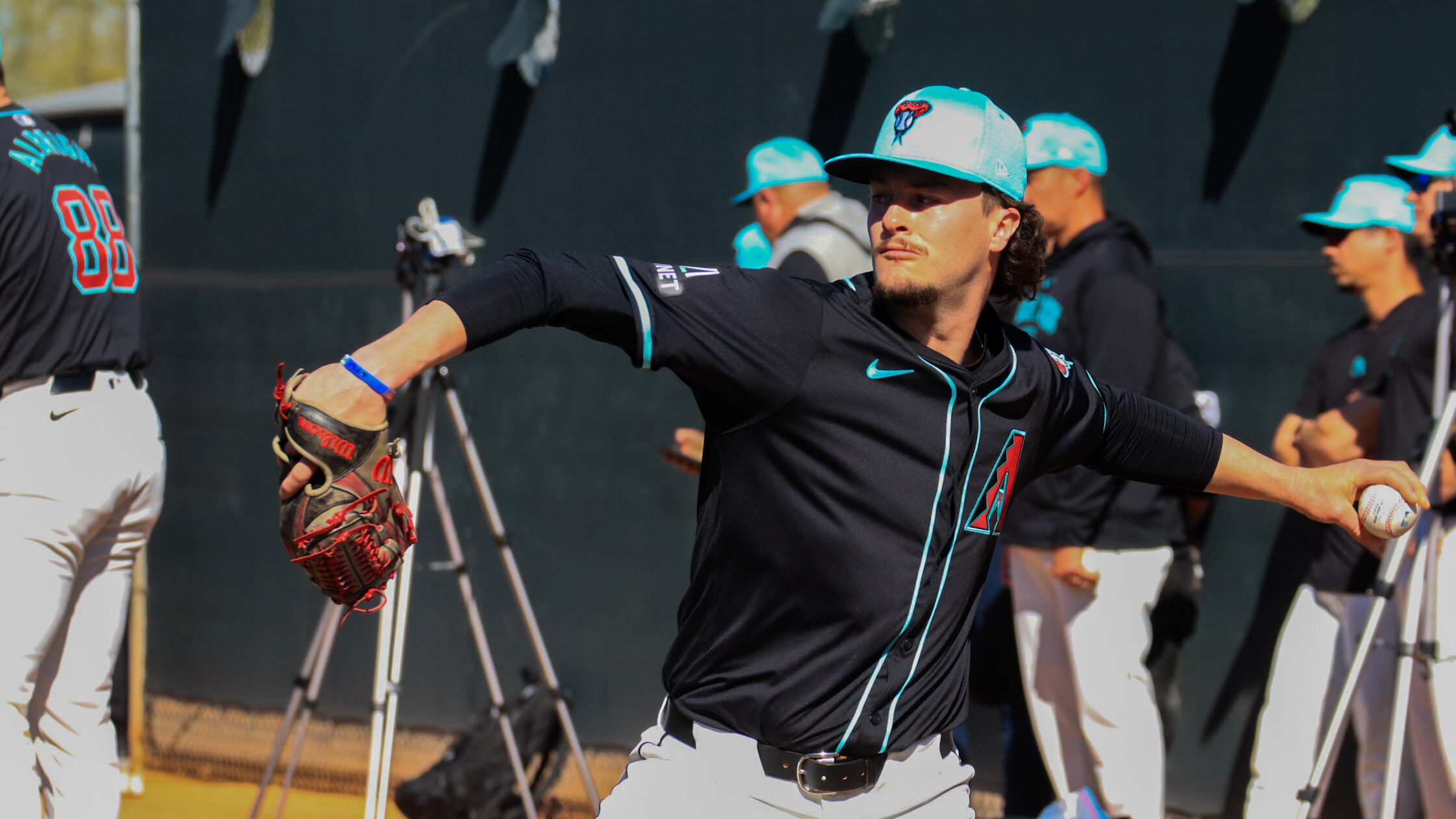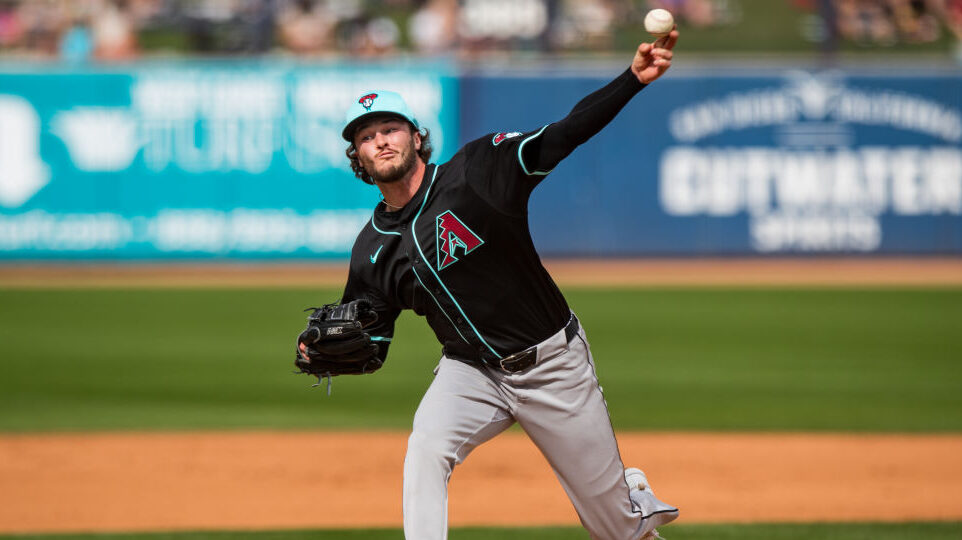Q&A: Former Diamondbacks OF Chris Young shares advice to team, previews Dream Series
Jan 11, 2024, 3:29 PM

Chris Young #24 formerly of the Arizona Diamondback during Opening Day against the San Francisco Giants at Chase Field on April 6, 2012 in Phoenix, Arizona. (Photo by Christian Petersen/Getty Images)
(Photo by Christian Petersen/Getty Images)
Chris Young has not strayed too far from the baseball field after his 13-year MLB career ended after the 2018 campaign. The longtime Arizona Diamondbacks (2006-12) outfielder has stayed engaged with the league as an analyst for MLB Network.
That led him back to Chase Field to cover Arizona’s World Series appearance last fall, allowing him to reconnect with familiar faces.
“When I’m on the field, back at Chase Field … being able to see the training staff that’s still there, the equipment crew that’s still there, the grounds crew that is still there, to see all of those guys, I really still feel connected with that organization,” Young told Arizona Sports.
In May, Young will be a team captain in the Hall of Fame East-West Classic, a tribute to the Negro Leagues All-Star Game to honor the history of Black baseball players. This weekend, he’ll be involved in covering the future.
The Dream Series returns to Tempe Diablo Stadium for Martin Luther King Day weekend as a developmental camp from MLB and USA Baseball to help diversify the sport’s talent pool. It offers Black and Latino high school players from around the country instruction from major leaguers, former pros and managers. Cy Young winner CC Sabathia and MLB chief baseball development officer Tony Reagins will be special guests for the 80 high schoolers.
The event is in its seventh year, established enough to have big-league alums such as Hunter Greene of the Reds, Josiah Gray of the Nationals and Michael Harris II of the Braves. The D-backs’ 2022 first-round pick Druw Jones was also a participant.
Young and Harold Reynolds will host MLB Network’s coverage of the Dream Series from Tempe starting Friday at 7 a.m.
Q: Was last year the first time you saw the Dream Series?
That was my first time experiencing it in person, which was a truly an amazing experience to cover. Once you’re there and you see the passion that these coaches — you’re talking about Jerry Manuel, former big-league managers, last year we had Mike Scioscia — seeing the passion they have in passing their knowledge down and how receptive the younger generation is surprised me. Before going to it, there was this almost a facade of me thinking the younger generation isn’t as worried about what the older generation has to say because the game has changed so much. But when you see the respect these players have for the former players giving time and effort to share knowledge with them, it was a really special experience. It’s not just the coaches, current players were there. Last year, you had Jo Adell, Howie Kendrick fresh off the field. They’re giving instruction to the players and whether it’s the Dream Series or Hank Aaron (Invitational), you have a lot of players take the time to share information with the youth, which is beautiful to see.
Q: Did you notice a demographics change in baseball during your career?
I remember my parents, especially my dad, telling me stories about their favorite players growing up. Growing up as a baseball fan when I was under 10 years old, I remember seeing a lot of Black players and a lot of Black stars playing the game. We had Ken Griffey Jr., but you also had plenty of other players on every team. Sometimes you’ll see six or seven, but you would see a couple at least on every team. … You started to see teams that had zero or the playoffs would come around and you see zero to where it was a drastic shift at some point where it was obvious you were seeing less Black players. While I was playing, when you’re playing, you’re trying to focus on what you got going on and your career, but it was definitely obvious when you look across the dugout to the other side and you only see one other Black player.
Q: How did you see the young athletes take advice from players who played a long time ago now compared to current big leaguers?
When it comes to the core of the game, baseball is still baseball. Nothing can match the stories and experience that former players and coaches could bring to the players. That’s not just on-the-field experience, that’s off-the-field experience. They have seminars where they’re sitting in more of a classroom setting where players can ask questions about what to expect. That resonated with me because when I was that age, I got drafted out of high school, I had no clue what professional baseball was like. I had no clue what to expect that first day I stepped into a clubhouse and how to feel comfortable and how to understand that I was the best in my region I was in. But now I’m about to go compete with the best from all over the world. Being able to hear stories from former players and managers preps the next generation so they’re not caught off like a deer in headlights when they step onto a major-league field.
Q: Onto the Diamondbacks. In 2007 you had a big rookie season and the team went on a postseason run. How did you try to build on that individual and team success, a place where many current D-backs are after 2023?
We were spoiled right out the gate. I came up in 2006 but my rookie season was 2007 and we went to the playoffs that year. I remember sitting in the clubhouse and some veteran guys telling us, ‘Hey, don’t take this for granted. It’s not going to be easy,’ but me being the young guy, you’re like, ‘We’re good. We’re going to be here. We just went to the postseason.’ You’re young and you’re excited and you’ve been used to winning probably. Most kids playing, you win in high school, we won in the minor leagues, you just expect to continue to win. And sometimes that naiveness helps you feel more powerful. We saw what the Diamondbacks did last year. Everyone says you have to have a veteran team to go deep into the postseason. The Diamondbacks had a few veteran players last year, but their core was their youth. They allowed that to energize them through the World Series. Going into this season, you can’t allow the last season to dictate anything about how you feel. You got to understand that you’re starting from scratch again. We came out the gates hot and then we didn’t make the postseason for a while. That was something I struggled with and I understood that we never take it for granted. That pushes you to work harder on a personal level but to also work harder as a unit and understand the value in the team chemistry.
I like bolstering the pitching staff with (Eduardo Rodriguez) and bringing in (Eugenio Suarez) for some power. So now it is that youth, it is their responsibility to welcome and help those guys understand what our culture is. What is D-backs baseball? You need everybody to buy into that philosophy. For the D-backs last year, it was being aggressive on the bases and playing good defense. I don’t think anything changes this year. If they get away from that is when you start to see trouble but if they stay close to their identity, I think they’ll be fine.
Q: Was there anything extra to watching the D-backs beat the Brewers in the postseason after 2011?
It was a couple of things for me. Seeing the Diamondbacks jump into the swimming pool took me back to when we got beat by the Dodgers and the Dodgers jumped in the pool. Seeing the Diamondbacks play the Brewers again and the Diamondbacks taking that series, it was nostalgic for me. I remember that series going to Game 5, lost the first two games in Milwaukee, went back to Chase Field and took care of business and ended up getting walked off by Nyjer Morgan. Still leaves a sour taste in my mouth. Even if it wasn’t being able to get that hit back, I’m glad the new generation took care of business for us.
Q: How good can Corbin Carroll get?
I think he’s a superstar. I really do. I think we’ve just seen the beginning of him. I know minor league numbers don’t mean everything, but when you were as dominant as he was in the minor leagues and being able to carry that success into the major leagues, play on the biggest stage, play in the World Series and continue to get better and not let any big moment get too big. I think he’s going to continue to learn himself, learn his power. I think low end for him is 30-30 on a yearly basis. I mean, 30-50 is something I think we may start to associate with Corbin Carroll. … It’s not too many guys who can produce on both sides of the ball, be a team leader and even at a young age come off as the face of the team and take that responsibility. It reminds me a lot of what Paul Goldschmidt was when I was there. Goldy came in, took care of his business, trusted his game, didn’t try to change his game for anybody and stayed even keel. I feel like Corbin Carroll is very similar to Goldy in that respect.







